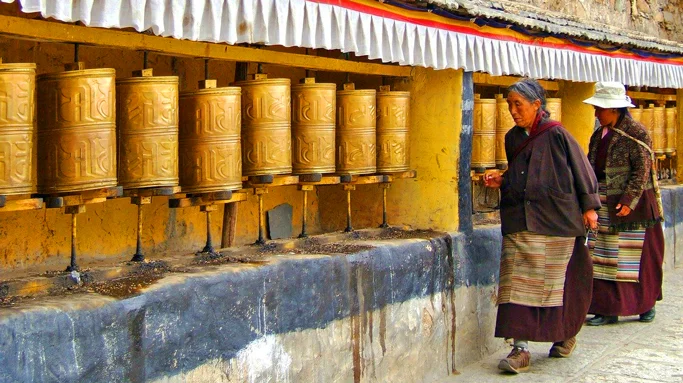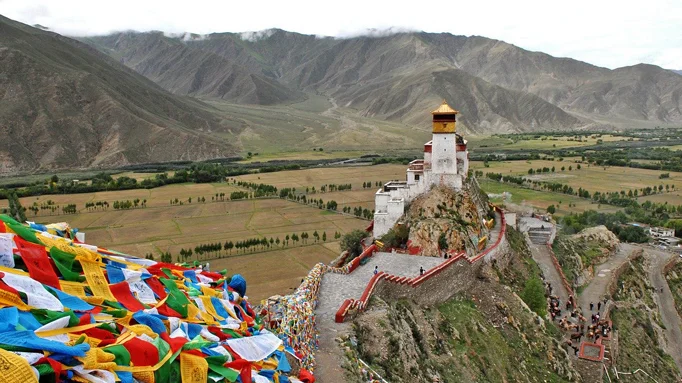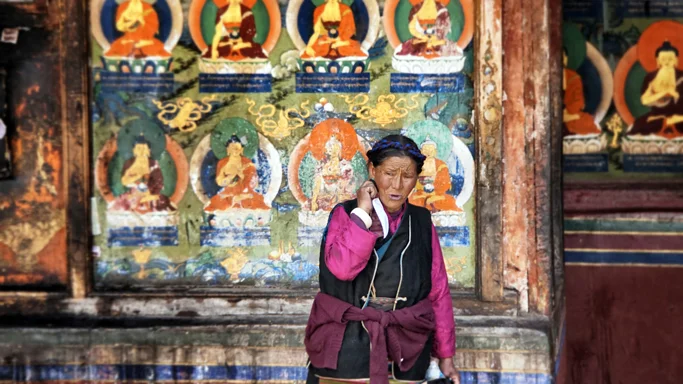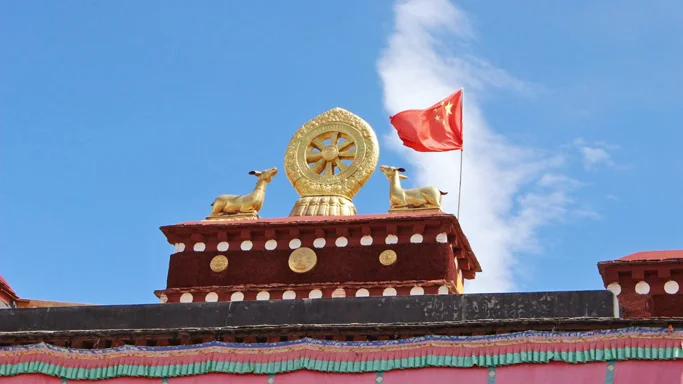Newsletters Trips@Asia
Dalai Lama- A short lived position
In a modern world where celebrities like Justin Bieber and Beyonce are idolized, the 14th Dalai Lama has managed to become an icon, recognized all over the world as a spokesman for Buddhism. Due to his phenomenal rise to stardom, people often mistake him as THE Dalai Lama. As a matter of fact, most of us don’t know that he is the most recent in a historical linage of spiritual leaders of the Gelug sect in Tibetan Buddhism. Historically, Sonyam Gyatso, the third Dalai Lama was the first one to bear the title in his lifetime. The title Dalai Lama, meaning “Ocean of Wisdom”, was granted to him in 1578 by Altan Khan, a descendant of Genghis Khan who was ruling a large chunk of Central Asia at the time. Since then, till now, his two predecessors and all successors have been carrying the notorious title.

For centuries, the Tibetans have worshipped the Dalai Lamas, believing that they are A Living Buddha who has been reincarnated over and over again to help all sentient beings. Sadly, all that adoration didn’t prevent several officeholders from dying before the age of 27 under suspicious circumstances.

The Potala Palace, a seat of power for nine successive Dalai Lamas, is not the type of place that is expected to be soaked in corruption. Yet during much of its existence, the palace was turned into a bloodstained battlefield by Tibetan nobles, Chinese governors, Mongol rulers and even Buddhist monks, who vied for dominance over Tibet. Sadly, the most documented victims of this conflict were the Dalai Lamas.

It all began with the death of the Fourth Dalai Lama. Yonten Gyatso was born into a prominent noble Mongolian family in 1589. His grandfather was Altan Khan, who first ordained Sonyam Gyatso as A Dalai Lama. Because of his family’s persistence to raise him themselves until he come of age, the Fourth Dalai Lama arrived in Tibet when he was already 14 years old, accompanied by his father and a thousand Mongol cavalry. Upon their arrival in Lhasa, a huge ceremony was held to enthrone the young boy. Even though the Tibetan nobles acknowledged that an alliance with Mongols would protect their country from powerful neighbors like China, most civilians were not happy with their foreign leader. Fearing that the next reincarnations might be chosen from other countries again, many attempted to overthrow the newly appointed Dalai Lama. Mysteriously, only a year after receiving his full monk ordination, the Fourth Dalai Lama died at the age of 27. Some say he was poisoned, but evidence is still lacking to date.

In order to carry out the construction of the Potala Palace without setbacks, the Fifth Dalai Lama ordered his regent Sangye Gyatso to keep his death a secret. For twelve years, they hid his death from public, claiming that the Dalai Lama was simply taking a long retreat. On important occasions, his ceremonial gown was placed on the throne or sometimes an old monk who resembled the Dalai Lama was posing in his place.

Meanwhile, the sixth Dalai Lama, Tsangyang Gyatso, was brought near Lhasa to be trained when he was only five. In 1697, when the palace was completed, the 14-year-old was finally enthroned as the Sixth Dalai Lama. As a teenager, the Sixth Dalai Lama showed less interest in his studies and rather embraced a playboy lifestyle. Only a few days before taking his full monk's ordination, he even visited the Panchen Lama, Tibet’s second highest religious leader, requesting permission to abandon his novice vows. Although he was allowed to reside in the Potala Palace, he spent most of his time outside, writing love songs, drinking in taverns and enjoying company of women.

At the time, China was ruled by the Kangxi Emperor, undoubtedly the most fearsome ruler in the county’s history. Thanks to its association with just as fierce Mongols, Tibet was spared from Chinese invasion for many years. Consequently, the Kangxi Emperor reported to Mongols that the extensive cover-up of the Fifth Dalai Lama's death was a political maneuver of Tibet’s regent (a different position, overseeing the country’s political power, while the Dalai Lama resort to managing the country’s spiritual matters) who wants to govern Tibet himself.

This narrative was quite convincing since the Sixth Dalai Lama showed no interest in politics and the regent was managing the country's affairs on his behalf with no intervention. After hearing such a compelling story, a Mongol ruler, Lhasang Khan, decided to use it as an excuse to invade Tibet. In 1706, with the approval of Kangxi Emperor, Lhasang Khan took Lhasa by force. The warlord found monks who then signed a petition that the Dalai Lama was not fulfilling his responsibilities. Following the petition, the Mongols arrested the young man and proclaimed another monk as a real incarnation. The Sixth Dalai Lama disappeared while in custody at the age of 23. Regardless of his disgraceful acts, Tsangyang Gyatso was loved by the public because of his charisma and charm. A few years later, Tibetans appealed to the Dzungars, another powerful Mongolian tribe, to depose the Sixth Dalai Lama who replaced Tsangyang Gyatso.

During the reign of the Seventh and Eighth Dalai lama, who lived a long life by the standards of that period, Tibetans enjoyed peace and prosperity for roughly 100 years. Unfortunately, it did not last long. The Qianlong emperor, whose reign marks the golden age of the Chinese Qing Dynasty, has died in 1799. Soon, the empire started trembling due to the drain of silver to the West, paying for the opium smuggled into China from British India. Having their hands full with a task to improve the economy, the next emperors were too busy to pay much attention to its vassal states. As soon as Beijing stopped sending enough money to its diplomats for lavish gifts, they quickly lost the alliance of the Tibetan aristocracy who had once collaborated with the Qing Dynasty. The nobilities now began to pursue a chance to regain the power they had lost since 1750. From the Chinese perspective, in such an unpredictable scenario, having a Dalai Lama who can think for himself was a dagger to the heart. While in the eyes of Tibet’s nobility, a Dalai Lama who answered to Qing was only a pretender who deserves death. For one reason or another, all parties had a motive to murder the Dalai Lama.

There were various questionable circumstances, which might account for the premature deaths of the Eight Dalai Lama’s four successors. Initially, the deaths began almost immediately after the Chinese had introduced a reform concerning the selection of a new Dalai Lama. A traditional process was consisted of looking for signs and wonders, a test in which a candidate should choose from various personal items, some of which had belonged to earlier incarnations and many other assessments. Unsurprisingly, the new rules had drawn lots to choose a candidate, allowing the Chinese to manipulate the selection process. Much to their dismay, Tibetans somehow managed to avoid exploitation during the selection of the ninth and tenth Dalai Lamas. Thus, with the purpose of enthroning a candidate they had supported, the Chinese may have gotten rid of these two incarnations. Another suspicious coincidence is that all four successive Dalai Lamas, who died mysteriously, had made a sacred trip to Lhamo Latso Lake prior to their demise. Leaving Potala Palace on a long journey has exposed them to many outsiders who may have used the chance to poison them.

First of this series of untimely deaths had occurred in 1815, when the Ninth Dalai Lama, nine-year-old Lungtok Gyatso, got severely sick with a chest infection and died shortly after. The only record that we know of is that the boy passed away at the Potala Palace, following a visit to the lake, and that many death threats were made against him before the unfortunate event.

The Tenth Dalai Lama, Tsultrim Gyatso, lived longer, almost turning 21 before he fell ill in 1837. Right before his death, Tsultrim had announced his plans to renovate the Tibetan economy and increase taxation. According to Tibet’s formal documents, he completely lost his appetite and suffered from shortness of breath. Various treatments were overseen, and massive prayers organized, but his health continued to decline, leading to his death. However, Chinese sources say otherwise. It states that his death was not caused by some disease but by a collapse of ceilings on him while he was sleeping. Once his staff had removed all the rubbles and dirt, they found a large cut on the holy man’s neck. There is no proof to conclude if the strange wound was perpetrated by an assassin or simply by falling bricks, but it is agreed by historians that the person who had the biggest motive to get rid of the Tenth Dalai Lama was his regent. The regent was himself a reincarnated holy lama who held power since 1822. The Dalai Lama had conveniently died just weeks before turning 21, an authorized age to assume the full powers of his office and no longer needing for a regent.

The Eleventh Dalai Lama also did not live so long, dying at only 18. It is said that his health had been neglected during many years of rigorous training and many rituals which he was expected to oversee. Like the others, there is no evidence to prove if his death was unnatural or not, but the situation was rather odd as always. He died in the middle of a dreadful war between Tibet and Nepal. In such a critical moment, the Eleventh unexpectedly turned out to be the first in 65 years to assume full political power and government without a regent. This decision alone was probably enough to make him a threat to many powerful nobilities in Lhasa.

The Twelfth Dalai Lama, Trinle Gyatso, was enthroned in 1873 at the age of 18. He never stamped his full authority as he died of an unexplained illness only two years later. It is said that the holy man fell ill in winter and died in just two weeks. The puzzling thing is that this illness had not constrained Dalai Lama to bed rest, and he was found dead seated in meditation. The Chinese ambassadors ordered his remains to be kept in the same position and all the objects in his bedchamber in the same place. They then had all his attendants locked up and closed the case since the autopsy was inconclusive. Trinle was the first Dalai Lama to be chosen by the Chinese selection process. Thus, many saw him as Beijing’s man, making him less favored than the previous Dalai Lamas among Tibet’s nobles, which might explain why he died.

To sum things up, we can conclude that the Twelfth Dalai Lama and many of his predecessors were victims of power struggles between the religious and political fractions in Tibet, which was heavily encouraged by the Chinese. Like any other country in the middle age, Tibet was no exception when it comes to violence. Although, Tibet was nowhere near launching crusades, it was still a dangerous place where monks and monasteries fought viciously among themselves in secret, even resorting to murder the Dalai Lamas if need be.
ACROSS THE TIBETAN PLATEAU | TIBET PRIVATE TOUR
A unique journey through the Tibetan Plateau- the Roof of the World as it is commonly known. Come and indulge in the intriguing world of Tibetan Buddhism and lifestyle.
VIEW TOUR